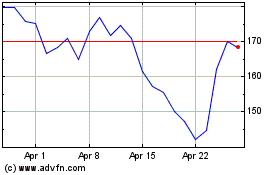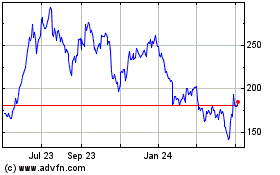By Tim Higgins
Elon Musk's plan to build Tesla Inc.'s fourth vehicle assembly
factory represents the next phase in his effort to reshape the auto
maker to rapidly increase the number of electric cars it can sell
each year as it races to compete with global rivals.
The chief executive's announcement Wednesday that work has
already begun to prepare building a factory on more than 2,000
acres outside of Austin, Texas, marks one of the few new major car
assembly plants to be built in the U.S. in the past decade, and
comes while the rest of the auto industry is navigating through a
global pandemic and fears of a prolonged recession.
The factory, slated to begin production next year, would employ
at least 5,000 workers and build the Cybertruck pickup and other
vehicles. The truck, revealed last fall, drew enthusiasm -- and
some jeers -- for its "Blade Runner"-inspired appearance.
The Texas factory continues a building boom for Mr. Musk, who
opened a second assembly plant in China late last year, as he looks
to turn Tesla into a major auto maker. In 2017, Tesla sold about
100,000 vehicles. This year, the company aims to deliver 500,000
cars and sport-utility vehicles, though it cautioned on Wednesday
that economic uncertainty from the pandemic will make that more
difficult.
Beating out Tulsa, Okla., for the new factory, Texas Gov. Greg
Abbott cheered the more than $1 billion in planned investment and
jobs that the new assembly factory would bring to the area. His
office said Tesla didn't receive any state incentives to locate in
Texas, while local authorities have approved tax incentives
totaling about $60 million over several years.
Tesla's China plant allowed the company to continue building
cars during the second quarter when its lone U.S. assembly plant in
Fremont, Calif., was shut down for several weeks as part of an
effort to slow the spread of Covid-19.
The company is working to expand the China factory so it can
assemble the Model Y compact sport-utility vehicle, Tesla's latest
offering. The Model Y began U.S. deliveries in March and is
expected to overtake the Model 3 as its bestseller.
Earlier this year, Tesla began work to build a third assembly
plant outside of Berlin.
The added capacity could allow Tesla to build more than 2
million vehicles annually by the middle of the decade, according to
a note to investors from Emmanuel Rosner, a Deutsche Bank analyst.
BMW AG's namesake brand, for example, sold about 2.2 million
vehicles last year.
Tesla critics, some of whom are betting against the company by
short selling its stock, question if there is truly enough demand
for so many Tesla vehicles, noting recent price cuts.
On Wednesday, Mr. Musk was adamant that wasn't a concern.
"Demand is not a problem," he said.
During a public conference call with analysts, Mr. Musk was
joined by Jerome Guillen, president of Tesla's automotive division,
in talking about the need to hire additional workers to help with
manufacturing. "We want more people," Mr. Guillen said.
Mr. Musk became deeply interested in improving and automating
the car-building process after painful struggles to increase
production of the company's first SUV, the Model X, in 2016.
In a rare public acknowledgment of error, Mr. Musk conceded in
2018 that he went overboard with his automation attempts for the
Model 3. That mistake snarled the company's efforts to ramp up
production in 2017 and 2018 -- a dark period that shook investor
confidence in his ability to execute on his vision for Tesla to
evolve from a niche luxury brand into a mainstream electric-car
company.
That confidence has never been stronger. Shares this month have
risen almost 50%, though they dipped on Thursday along with the
rest of the market. For the year, Tesla's market value has nearly
quadrupled.
The factory expansion is a further acknowledgment by Tesla that
some of its founding assumptions were off. The original business
plan for the company, founded in 2003, was to create a car company
resembling more of a personal technology company, rather than a
traditional auto maker, by outsourcing vehicle assembly much like
how gadgets were made.
But that effort was eventually abandoned as Mr. Musk began to
realize the importance of controlling more of a company filled with
complex logistics and manufacturing nuances.
He has since brought in-house more of his supply chain than is
normal for a car maker, including seat manufacturing, and developed
greater expertise in battery cell manufacturing.
Mr. Musk said Wednesday that a lack of battery cells at an
affordable price is limiting the company's growth. Tesla is
expected to provide an update on its evolving battery strategy in
September.
He also said the Fremont factory, outside of San Francisco, will
continue to be important, despite suggesting in May he might close
it down and relocate the company's Palo Alto headquarters amid
frustration with local California authorities over the plant's
closure.
In fact, on Wednesday, Mr. Musk said the Fremont factory will
continue to be part of the company's plans, saying assembly will
continue there of its large sedan and SUV along with the Model 3
and Model Y for the western half of North America.
He also teased that the coming Roadster sports car might be made
in California. "We will continue to grow in California," he
said.
Records filed with local authorities in Texas show Tesla plans
to build a 4 million to 5 million square ft manufacturing facility
there over a period of two to three years. Mr. Musk later described
the plant as the company's biggest property when asked what kind of
production volume to expect. Tesla plans to begin operations in the
fourth quarter of next year, the records show.
In picking Austin, Tesla is joining tech companies, such as
Facebook Inc. and Apple Inc., in seeking a location with a lower
cost of operating compared with Silicon Valley. Mr. Musk touted the
factory's location near the Colorado River, saying the company
planned a boardwalk and trails for hiking and biking.
"We're going to make it a factory that is going to be stunning,"
Mr. Musk said. "It's going to basically be an ecological paradise
-- birds in the trees, butterflies, fish in the stream."
Write to Tim Higgins at Tim.Higgins@WSJ.com
(END) Dow Jones Newswires
July 23, 2020 17:24 ET (21:24 GMT)
Copyright (c) 2020 Dow Jones & Company, Inc.
Tesla (NASDAQ:TSLA)
Historical Stock Chart
From Mar 2024 to Apr 2024

Tesla (NASDAQ:TSLA)
Historical Stock Chart
From Apr 2023 to Apr 2024
